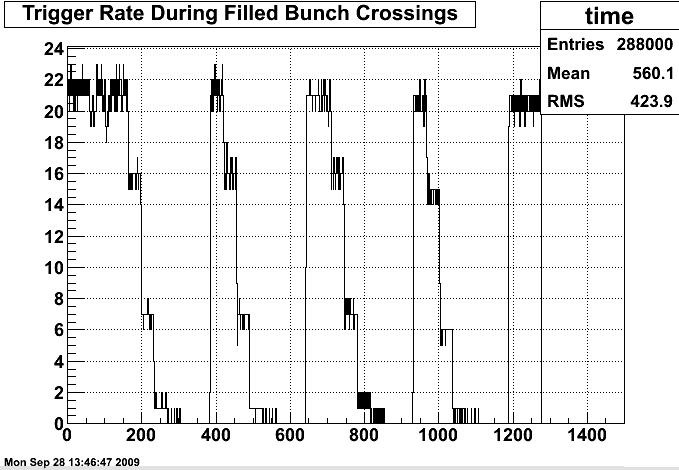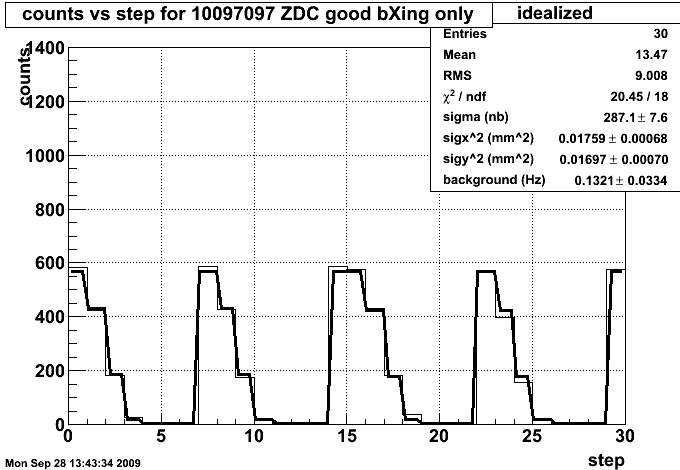- rcorliss's home page
- Posts
- 2013
- January (1)
- 2012
- 2011
- 2010
- December (1)
- October (2)
- September (2)
- August (2)
- June (2)
- May (3)
- April (3)
- March (5)
- February (2)
- January (8)
- 2009
- December (5)
- November (1)
- October (7)
- September (10)
- August (4)
- July (3)
- May (1)
- February (1)
- January (1)
- 2008
- 2007
- My blog
- Post new blog entry
- All blogs
Reproducing a rough estimate.
An email contained the following notes from Bill Christie regarding the BHT3 cross section, and I want to reproduce this logic to
Absolute lumi run 10088078 , low dead time, only BHT3=31 + BBC,ZDC prescaled
• BHT3/baseZDC=1.64e-4
• ZDC cross section from Angelika=2.3 mb, crude
• Joe's calculation of luminosityHi All,
Here is the calculation of the run9 cross section number. So Angelika gave us 4 vernier scan luminosities
fill# date time L(10^31 s^-1cm^-2)
10207 02/23 11:06-09 0.3
10276 03/01 11:32-36 1.8
10399 03/20 13:24-30 2.6
10415 03/24 10:02-08 2.8
Only the last one of those time periods had a trigger mix that seem to working correctly. I looked for the closest (in time) run number before the scan (run# 10083059) and got the ZDC rate as given by the Trigger Details link in the RunLog. That number was 71513.5. All runs near the other scans gave the ZDC rate as 1000 exactly and I figure that is not correct so I will only calculate the cross section from this last number. So starting with the standard formula
dN/dt = Rate = xsec*instant_lumi
and inverting
xsec = Rate/instant_lumi = 7.15e4/2.8e31 = 2.554e-27 (cm^2) = 2.554 mb
Note that this number disagreed with the number Bill remembered earlier, but provided I am getting the correct ZDC rate this should be correct. Now from run# 10088078 (that we took earlier today) we know that the ratio of the BHT3 xsec to the ZDC xsec is 1.64e-4. Recall that we restricted the run to a low rate so that dead time is not an issue in any of the determinations.
xsec(BHT3)/xsec(ZDC) = 1.64e-4
xsec(BHT3) = 1.64e-4*xsec(ZDC) = 4.18e-4 mb
The first step is to try and get the ZDC cross section. I perform the same analysis as on the previous pages, but this time for the ZDC trigger in 10097097. I fill the bare rate plot for the good bunches (all bunches except those in the abort gaps, or otherwise only partially filled). This results in a clean rate plot very much like the BBC plots we've seen earlier.

Figure 1. Rate as a function of time for the ZDC trigger in 10097097. Entries in this histogram come from only the good bunch crossings where both beams had full buckets. The vernier scan sweep can be very clearly seen.
Running through the same alignment and rebinning, we can then fit as before:

Figure 2. Counts as a function of vernier scan set, with fit superimposed. The resulting widths are a good deal smaller than I expected, differing from the BHT3 widths by roughly 20%.
The resulting cross section is 287nb, which we then have to correct for the prescale factor (in this case 3000 [listed] * 1 [from details] ), so the corrected cross section is 0.86mb This is pretty far off from the 2.5mb that Bill has from a different process. If I assume the widths are somehow aritficially small, I can correct the cross section by multiplying by the ration of the 'correct' widths to these (~23/17). This yields 1.17mb, which is close to half of the value Angelika reports and Bill calculates.
For the moment I can press on. The scaler/base_rate values for the ZDC and BHT3 triggers are 1.19e-1 and 8.78e-5, respectively. We can calculate the BHT3 cross section as being 0.86mb* the ratio of these two values, which results in 634nb, compared to the 525nb value we get from performing the vernier scan fit directly the BHT3 data. The value Bill gets is not significantly different from this, coming out as 418nb.
If I use the larger cross section (after 'correcting'), I'll get an even larger BHT3 cross section, 857nb.
If I use the ZDC cross section reported by Angelika, the result is 1696nb.
It's possible that the vernier scan run 10097097 is too high luminosity for the ZDC to be deadtime free, in which case we'd expect the real ZDC cross section to be larger than the value seen, which would once again shift the cross section in the wrong direction.
Have I missed something, or is this ~20% agreement close enough given the rough values used by Bill?
- rcorliss's blog
- Login or register to post comments
